

Teachers tap into brain science to boost learning. JUDY WOODRUFF: Next: neuroscience and education.
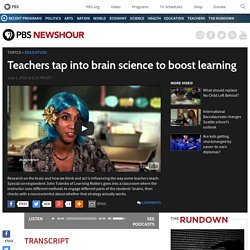
Thousands of teachers around the country are learning about an alternative teaching program that aims to use scientific discoveries about the brain to improve the way children learn in the classroom. Special correspondent John Tulenko of Learning Matters reports from Philadelphia. JASSELLE CIRINO, Teacher, Francis Scott Key Elementary: When I say class, you… CLASS: You stop what you’re doing. Look at the teacher. JOHN TULENKO: Today is Wacky Wednesday in Jasselle Cirino’s third grade classroom, which explains the blue wig. Mme Émilie: Whole Brain Teaching. Bonjour à vous!
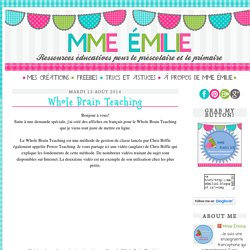
Getting Started with Whole Brain Teaching: The Core 4. It's so exciting to hear that so many of you are going to be trying Whole Brain Teaching this year!
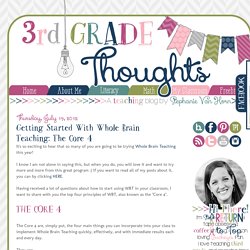
I know I am not alone in saying this, but when you do, you will love it and want to try more and more from this great program :) If you want to read all of my posts about it, you can by clicking HERE. Having received a lot of questions about how to start using WBT in your classroom, I want to share with you the top four principles of WBT, also known as the "Core 4". The Core 4 are, simply put, the four main things you can incorporate into your class to implement Whole Brain Teaching quickly, effectively, and with immediate results each and every day.
They are: Class-YesThe ScoreboardMirrorTeach-Okay They are meant to:Bring the class together (Class-Yes)Keep them motivated (Scoreboard)Get them active (Mirror)Build community and be accountable for their learning (Teach-Okay) As the teacher, I say, "Class? " This can include, but is not limited to: The tattooed teacher: whole brain post #1: rules, and babies. I love Whole Brain Teaching.

I can’t stress enough how it makes the day more fun for me and that’s what important, right? I am going to do a series of posts this week about my journey with wbt and how I incorporate it daily. I will be working on certification this year and leading a PLC at school. I started using a few strategies here and there in my last year of 4th grade. However, I really got down and dirty last year, which was my first year in second. Clip Chart Now, how to use both the clip chart AND wbt? Oh yea, and the babies! These are the quail that were the size of a quarter! The water fountain shoots a tad bit far. Whole Brain Teaching. Il y a plusieurs mois déjà, j'ai découvert le Whole Brain Teaching par le blog .
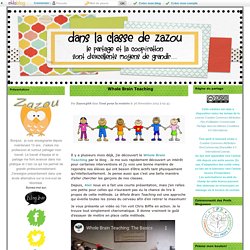
Je me suis rapidement découvert un intérêt pour certaines interventions et j'y vois une bonne manière de rejoindre nos élèves qui ont besoin d'être actifs tant physiquement qu'intellectuellement. Je pense aussi que c'est une belle manière d'aller chercher les garçons de nos classes. Depuis, Alet nous en a fait une courte présentation, mais j'en refais une petite pour celles qui n'auraient pas eu la chance de lire à propos de cette méthode. Le whole brain teaching - principes de bases. Voilà !
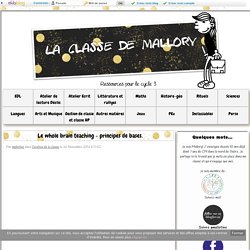
Dans un précédent article, je parlais de certaines techniques issues du "whole brain teaching" que j'avais mises en place dans ma classe. Je fais donc cet article en complément pour expliquer les principes de base de cette technique de management de la classe qui a pour but d'engager la totalité du cerveau dans l'activité d'apprentissage. Je précise que j'utilise certaines de ces techniques à petites doses en marge du renforcement positif que j'affectionne particulièrement. Ces techniques me permettent de créer une dynamique de groupe positive, là où le renforcement positif engage les élèves de façon plus individuelle. Whole Brain Teaching (Power Teaching) Lesson 1.
Whole Brain Teaching (Power Teaching) Lesson 6. Whole Brain Teaching (Power Teaching) Lesson 8. Program 517 Scoreboard. Level 1: The Scoreboard. 1.
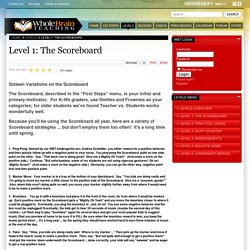
Ping-Pong: Named by our WBT kindergarten pro, Andrea Schindler, you either reward for a positive behavior and then quickly follow up with a negative point or vice versa. You ping-pong the Scoreboard, point on one side, point on the other. Say, "That back row is doing great! Give me a Mighty Oh Yeah! " (And make a mark on the positive side.) 2. 3. 4. 5. 7. 8. 9. WARNING: Don't keep switching up the games above. But what is the reward that your students, of any age, are working for? Here are some brand new versions of the Scoreboard!
More Scoreboards A central problem in education is that kids can become bored, sometimes with surprising speed, with any learning activity. 10. After using your Scoreboard for awhile, extend the center line upward and then draw another line crosswise on top of this center line. Obviously, you could morph the Scoreboard to an even higher level, call it College. 11. 12.
Draw a horizontal line across the middle of the Scoreboard. 13.